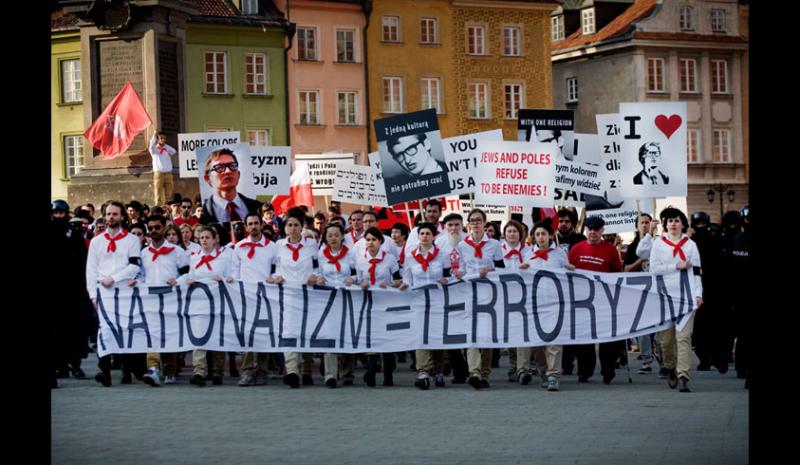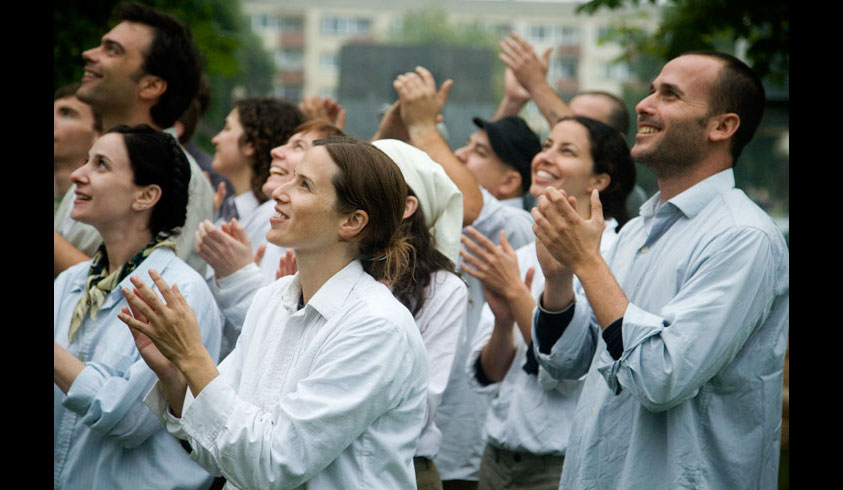Yael Bartana: And Europe Will Be Stunned, Artangel at Hornsey Town Hall | reviews, news & interviews
Yael Bartana: And Europe Will Be Stunned, Artangel at Hornsey Town Hall
Yael Bartana: And Europe Will Be Stunned, Artangel at Hornsey Town Hall
Flabby film triptych follows the course of a fictional Jewish Resistance Movement in Poland

In the cool, dim, municipal modernist interior of Hornsey Town Hall you’re confronted with a neon sign: And Europe Will be Stunned. It's the title of the trilogy of films at the heart of this Artangel-commissioned show by Israel-born Yael Bartana. The films are split in location around the building in an exhibition which includes neon slogans and posters which can be taken away, bearing manifestos in different languages.
The first film, Mary Koszmary (Nightmares) (2007), sees a young politician walk into the derelict and virtually desolate Decennial Stadium to deliver a contentious speech calling for the return of the 3.3 million Jews that left Poland in the wake of the German invasion in 1939. Delivered by real-life leftist thinker Slawomir Sierakowski, the leader’s speech reverberates about the breeze-swept plants growing from the ruins of the terraces and tarpaulin flapping from the surrounding scaffolding. Young scouts assist their leader, writing, “3,300,000 Jews can change the life of 40,000,000 Poles” on the pitch with line-marker. Comparisons with Riefenstahl's Triumph of Will (1934) are inevitable. The sheer symbolic power of stadium politics coupled with shots of swaying weeds covering the empty seats diverts us from this film’s failing: it’s a political speech, dully delivered with the kind of cloying metaphors that bad dictators love. This speech, we subsequently learn, inaugurates the fictional Jewish Renaissance Movement in Poland (JRMiP) which will seek to return Jews with Polish roots.
Behind the determined smiles of these settlers as they work is the horrific history of this symbolic site
In the second, more promising, film, Wall and Tower (2009, pictured below right), we witness the building of a kibbutz by members of the JRMiP on the site of the Warsaw Ghetto. The film of course deliberately echoes the propaganda films of the 1930s and 1940s as spirited young pioneers dig holes and erect fences. The result is a barbed-wired compound with a watchtower and searchlight under a flag bearing the symbol of the JRMiP: a darkly suggestive combination of the Polish Eagle with the Star of David. Behind the determined smiles of these settlers as they work is the horrific history of this symbolic site. They lie at rest in a pile of woven bodies in a way that is sexually suggestive as well as evocative of those images we have all seen of Europe’s bloody past. The final narrative, Assassination (2011), takes place after the assassination of the JRMiP’s leader. A state funeral is held and a rally takes place with eulogising speeches by actors and real-life political figures. It’s a high production value piece, but unconvincing in its portrayal of such an occasion. The scenes are stilted and bathetic in places: a Soviet-like statue of the leader awkwardly bears his thick-rimmed glasses; a placard reads “I AM SAD”; and a particularly cringe-worthy moment occurs when a choir sings. It feels nothing like a real rally of such a kind.
The final narrative, Assassination (2011), takes place after the assassination of the JRMiP’s leader. A state funeral is held and a rally takes place with eulogising speeches by actors and real-life political figures. It’s a high production value piece, but unconvincing in its portrayal of such an occasion. The scenes are stilted and bathetic in places: a Soviet-like statue of the leader awkwardly bears his thick-rimmed glasses; a placard reads “I AM SAD”; and a particularly cringe-worthy moment occurs when a choir sings. It feels nothing like a real rally of such a kind.
Bartana’s direction is more effective on a smaller scale. There are some beautiful isolated moments: the lit faces of children forming the JRMiP’s symbol with candles is both tender and powerful. The arrival of a phantom émigré in black with an antique case is a silent reminder of the horror that underpins this elaborate performance. She passes unnoticed through a line of masked guards and confronts the viewer with a provocatively ambiguous gaze. Despite these moments, the film largely makes for a tedious platform for the assembled speakers. The politics here is spelled out (mostly in English) in banners and speeches when an oblique approach would be more pertinent and moving.
What we ultimately have with all three films is a messy mix of history and the rhetoric and symbolism of nationalist politics. How the neon slogans and takeaway posters fit into this is all is questionable, both forms are contemporary art clichés and grate with the grave affairs on screen. The ambition and production value of the films is impressive but should we acclaim artists simply for their prowess in securing funding? No. And besides, despite the filmic quality, it’s still not a convincing dramaturgy, demanding more of the viewer’s suspension of disbelief than is reasonable. What is really lacking is the imaginative ability to distil these provocative themes into a coherent and economical set of (moving) images. What we have instead is the unwieldy juggling of tropes that are ingrained in our political consciousness and a hell of a lot of flabby rhetoric.
Watch a clip from Assassination
rating
Share this article
The future of Arts Journalism
You can stop theartsdesk.com closing!
We urgently need financing to survive. Our fundraising drive has thus far raised £49,000 but we need to reach £100,000 or we will be forced to close. Please contribute here: https://gofund.me/c3f6033d
And if you can forward this information to anyone who might assist, we’d be grateful.

Subscribe to theartsdesk.com
Thank you for continuing to read our work on theartsdesk.com. For unlimited access to every article in its entirety, including our archive of more than 15,000 pieces, we're asking for £5 per month or £40 per year. We feel it's a very good deal, and hope you do too.
To take a subscription now simply click here.
And if you're looking for that extra gift for a friend or family member, why not treat them to a theartsdesk.com gift subscription?

Add comment